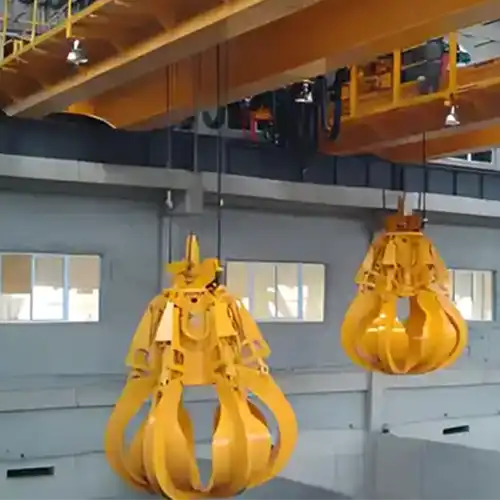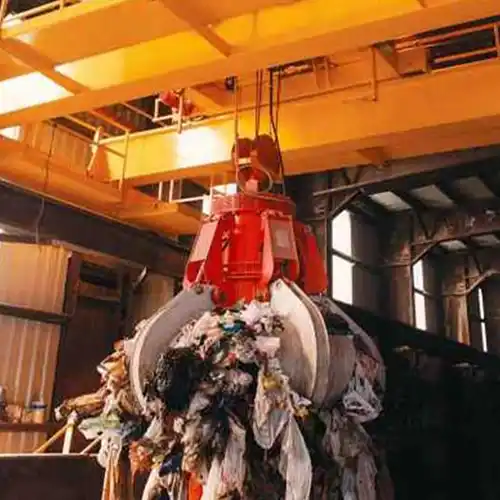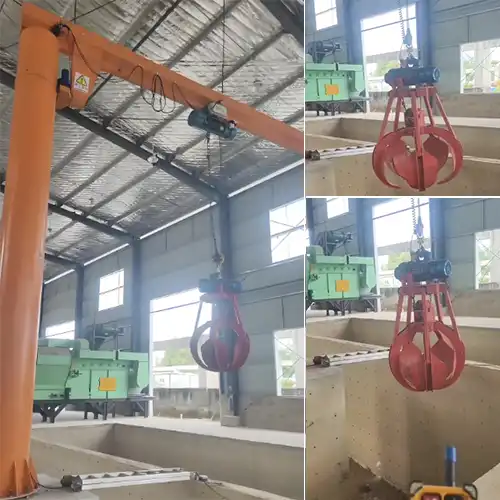Hydraulic Grab Bucket vs. Electric Grab Bucket, How to Choose Grab
Compare hydraulic grab bucket & electric grab bucket to find the best fit for your facility’s materials, environment,& operational needs. OH Crane bucket!
Category: Featured
Your Trusted Overhead Crane Grab Buckets Manufacturer & Supplier
Hydraulic Grab Buckets vs. Electric Grab Buckets
Which Is Right Crane Grab Bucket for Your Facility?
Grab buckets are a key part of modern material handling grab bucket cranes, used in industries ranging from ports and scrap yards to warehouses and waste power plants. They allow cranes to pick up, transport, and unload bulk materials efficiently, whether it’s coal, ore, grains, or construction debris. Essentially, grab buckets are what turn a crane into a versatile, productive tool for moving heavy or loose materials.
For facility managers, operators, and procurement teams, choosing the right type of grab bucket can make a noticeable difference in daily operations. Hydraulic and electric grab buckets are the two most common options, but they behave very differently and fit different work environments. Picking the wrong type can lead to frequent maintenance issues, lower productivity, or higher operating costs.
This guide is designed to give you a clear comparison between hydraulic and electric grab buckets. You’ll find practical insights into:
- Efficiency: How quickly and smoothly each type can move materials.
- Cost: Both upfront purchase costs and ongoing operational expenses.
- Operational suitability: Which type is better for indoor versus outdoor use, or for handling heavy vs. light materials.
By the end of this article, you’ll have a practical understanding of which grab bucket aligns with your facility’s specific needs. No fluff, just real-world considerations you can use when making a purchase decision.
Basics of Crane Grab Buckets
Before deciding between hydraulic and electric grab buckets, it’s important to understand how each type works, what materials they handle best, and where they are commonly used. Knowing these basics can save a lot of headaches and help you match the right tool to your facility’s needs.
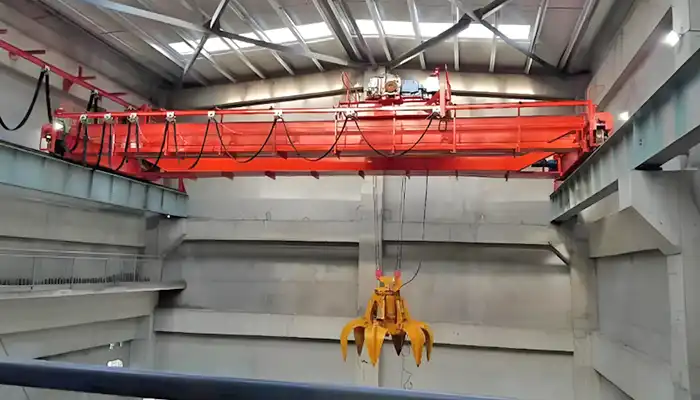
Orange Peel Hydraulic Grab Buckets for Double Girder Overhead Crane for Waste Handling
Hydraulic grab buckets rely on fluid power to operate. They use hydraulic cylinders to open and close the bucket, giving them strong gripping force. This makes them ideal for lifting heavy, dense, or irregular materials. The hydraulic system also allows for smooth, controlled movements, even under full load, which helps reduce spillage and ensures safer handling.
Common materials handled:
- Coal and ore in ports or mining operations
- Scrap metal in recycling yards
- Sand, gravel, and construction debris
Typical applications:
- Ports: Loading and unloading bulk materials from ships
- Scrap yards: Handling irregular metal pieces or heavy scrap
- Construction sites: Moving demolition debris or earth
Hydraulic grabs are favored in tough outdoor conditions. They can operate in dusty, wet, or abrasive environments, making them a reliable choice for heavy-duty material handling.
Electric Grab Buckets
Electric grab buckets, on the other hand, use electric motors and actuators to power the opening and closing of the bucket. They are more energy-efficient than hydraulic grabs because they don’t rely on a hydraulic system that constantly consumes fluid power. Electric grabs offer precise control, which is useful when handling lighter, fragile, or sensitive materials.
Common materials handled:
- Grains, fertilizer, and other agricultural products
- Wood chips, pellets, or biomass
- Light industrial bulk materials
Typical applications:
- Warehouses: Loading and unloading bulk products without spillage
- Industrial facilities: Moving light or medium-density materials efficiently
- Bulk material handling: Where precise placement and controlled handling are important
Electric grabs are especially suitable for indoor environments or facilities where noise reduction and clean operation are priorities. However, they are less suited for extremely heavy or abrasive materials compared to hydraulic grabs. If hydraulic grab buckets and electric grab buckets overhead cranes can not meet your needs, please chek our hot sale 12 types of grab buckets for your reference or leav a message down below and the tailored overhead crane grab buckets can be provided.
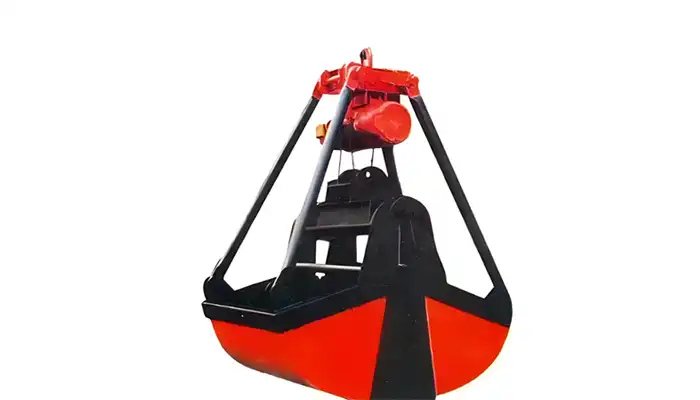
Key Comparison Metrics
Key comparison metris of Hydraulic Grab Buckets vs. Electric Grab Buckets. Check the following table for your general understanding, and details informaiton to make your decision. If you have any needs of hydraulic grab buckets or electric grab buckets crnaes, please feel free to contact us. WhatsApp: + 86 151 3871 1597.
Comparison Table for Your Reference
| Feature | Hydraulic Grab Bucket | Electric Grab Bucket |
|---|---|---|
| Power source | Hydraulic system | Electrical supply |
| Energy efficiency | Moderate | High (less energy loss) |
| Operating speed | Fast with high force | Precise, slower under heavy loads |
| Maintenance | Regular fluid checks, seals | Motor, wiring, control system |
| Durability | Handles harsh environments | Sensitive to moisture/corrosion |
| Noise levels | Moderate | Low |
| Initial cost | Moderate | Higher upfront cost |
| Operating cost | Higher due to hydraulic fluid, energy | Lower energy cost |
Power Source
- Hydraulic: Uses a hydraulic system powered by fluid under pressure. This system generates high gripping force, which is great for heavy or irregular loads.
- Electric: Relies on electricity to drive motors and actuators. It doesn’t need hydraulic fluid, which can simplify setup and reduce leaks.
Practical takeaway: Hydraulic grabs are better for heavy-duty work, while electric grabs fit well where electricity is readily available and lighter loads are handled.
Energy Efficiency
- Hydraulic: Energy is consumed continuously to maintain fluid pressure, which makes it less efficient over long shifts.
- Electric: Converts electricity directly into motion, losing less energy. This often translates into lower energy bills over time.
Practical takeaway: If your facility runs long shifts, electric grabs may save money on power.
Operating Speed
- Hydraulic: Opens and closes quickly with high force, so it handles heavy materials fast.
- Electric: Offers precise movements but can slow down under very heavy loads.
Practical takeaway: For speed and bulk movement, hydraulic grabs have the edge. For precision and controlled handling, electric grabs shine.
Maintenance
- Hydraulic: Requires regular fluid checks, seal replacements, and occasional cylinder servicing.
- Electric: Maintenance focuses on motors, wiring, and control systems, with fewer fluid-related issues.
Practical takeaway: Hydraulic grabs need more frequent attention, especially in dusty or abrasive environments. Electric grabs are simpler in clean indoor settings.
Durability
- Hydraulic: Built to withstand harsh outdoor conditions, including moisture, dust, and abrasive materials.
- Electric: Sensitive to moisture and corrosion, making it less suitable for rough outdoor environments.
Practical takeaway: Outdoor ports or scrap yards usually benefit more from hydraulic grabs.
Noise Levels
- Hydraulic: Moderate noise due to pumps and fluid movement.
- Electric: Low noise operation, ideal for indoor or noise-sensitive facilities.
Cost Considerations
- Initial Cost: Hydraulic grabs usually have a moderate purchase price, while electric grabs often come with a higher upfront cost.
- Operating Cost: Hydraulic grabs have higher energy and maintenance costs due to fluid and system upkeep. Electric grabs typically consume less energy, lowering long-term operating costs.
Practical takeaway: If budget allows, electric grabs can save money in the long run, especially for facilities with lighter, indoor handling needs.
Use Cases and Facility Considerations
Choosing the right grab bucket isn’t just about specs. Where and how you plan to use it can make a big difference in efficiency, maintenance, and overall cost. Let’s look at practical scenarios for both hydraulic and electric grabs.
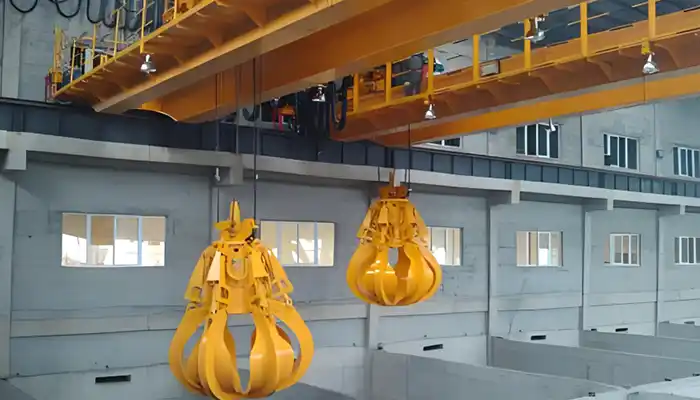
Hydraulic Grab Buckets Overhead Cranes for Intelligent lHeavy Duty Material Handling
Hydraulic grabs are built for heavy-duty work. They are ideal for situations where raw power and durability matter more than fine control.
Best use cases:
- Bulk handling: Coal, ore, sand, gravel, or scrap metal in large quantities.
- Outdoor operations: Ports, quarries, construction sites, and scrap yards.
- Heavy-duty materials: Irregular or abrasive items that require strong gripping force.
Why it works: Hydraulic systems can generate high force without slowing down, and their rugged design handles dust, moisture, and abrasive materials with minimal issues.
Electric Grab Buckets
Electric grabs are better suited for lighter, more precise handling. They are quieter, cleaner, and easier to maintain in controlled environments.
Best use cases:
- Indoor operations: Warehouses, factories, or bulk product storage facilities.
- Sensitive materials: Grains, pellets, chemicals, or materials prone to spillage or damage.
- Continuous handling: Facilities where grab cycles run frequently throughout the day.
Why it works: Electric motors provide precise control and lower energy use. They are ideal where noise, fluid leaks, or heavy maintenance would disrupt operations.
Environmental Factors to Consider
Your facility’s environment plays a big role in deciding which type of grab bucket will last and perform reliably:
- Humidity and moisture: Electric grabs may be vulnerable, while hydraulic grabs are more tolerant.
- Temperature extremes: Hydraulic systems can operate in a wide range of temperatures if maintained correctly.
- Dust and debris: Hydraulic grabs handle abrasive conditions better; electric grabs require cleaner environments.
- Corrosive materials: Extra protection may be needed for electric grabs; hydraulic grabs are generally more rugged.
Integration with Existing Equipment
Before purchasing, consider how the grab will fit with your existing cranes or automated handling systems:
- Compatibility with crane load capacity and boom type.
- Control system integration for automated or semi-automated operations.
- Power supply availability and safety requirements for electric grabs.
Practical takeaway: Matching the grab to both the material and the environment ensures smoother operations, fewer maintenance headaches, and better long-term cost control.
Cost-Benefit Analysis
When deciding between hydraulic and electric grab buckets, cost is more than just the purchase price. You need to consider long-term expenses, energy use, maintenance, and even the training your team will need. Looking at the full picture helps avoid surprises down the road.
Initial Investment vs. Long-Term Operating Costs
- Hydraulic grab buckets: Usually come with a moderate purchase price. They’re less expensive upfront, but hydraulic systems require fluid, pumps, and periodic maintenance, which can add to long-term costs.
- Electric grab buckets: Typically have a higher initial price due to motors and control systems. However, they often cost less to operate over time because they are energy-efficient and require less ongoing fluid maintenance.
Practical tip: If your facility handles heavy outdoor loads, hydraulic grabs may justify their cost. If you handle lighter loads indoors, an electric grab might save more money in the long run.
Energy Consumption Comparisons
- Hydraulic grabs consume energy continuously to maintain fluid pressure, which can make them less efficient during long shifts.
- Electric grabs convert electricity directly into motion, resulting in less energy loss and lower operating bills.
Practical tip: For facilities running multiple shifts or continuous operations, energy-efficient electric grabs can reduce monthly utility costs significantly.
Maintenance Frequency and Downtime
- Hydraulic grabs: Require regular checks for fluid levels, cylinder seals, and hoses. Downtime may be longer if a hydraulic component fails.
- Electric grabs: Focus on motor health, wiring, and control systems. Less fluid-related maintenance means fewer leaks, but electronics can be sensitive to harsh conditions.
Practical tip: Consider your maintenance team’s experience. Hydraulic grabs need staff familiar with fluid systems; electric grabs need staff comfortable with motors and electrical controls.
Labor and Training Implications
- Hydraulic grabs may require operators to adjust for flow rates, pressure, and load handling. Training is essential to maximize efficiency and safety.
- Electric grabs are often easier to control precisely, which can reduce operator fatigue and the learning curve, especially for repetitive handling tasks.
Practical tip: Factor in the cost of training and potential productivity loss during the learning period. Choosing the right grab type can save labor hours and reduce errors.
The best choice depends on your facility’s workload, energy costs, maintenance capabilities, and operator skills. Hydraulic grabs are strong and rugged for heavy-duty, outdoor tasks, while electric grabs can save money and improve precision in controlled indoor environments.
Efficiency Metrics
Efficiency is one of the most important factors when choosing between hydraulic and electric grab buckets. It's not just about speed; it's about how much material you can move safely, accurately, and cost-effectively. Let's break down the key metrics.
Throughput (Tons per Hour)
- Hydraulic grabs: Typically achieve higher throughput for dense or irregular materials because of their strong gripping force and rapid cycles.
- Electric grabs: Provide consistent throughput for lighter or uniform materials and are especially useful in continuous operations with minimal downtime.
Practical tip: Measure throughput not just by speed but by how many tons you can reliably move per hour without spillage or downtime.
Precision and Spillage Rates
- Hydraulic grabs: Strong force can sometimes result in minor spillage, especially with loose or small materials. However, proper operation minimizes losses.
- Electric grabs: Allow for more precise control, reducing spillage and material waste, which is important when handling grains, pellets, or fragile industrial materials.
Practical tip: Consider the type of material. High-value or sensitive loads often justify the precision of electric grabs, even if cycle time is slightly longer.
Cycle Time Per Load
- Hydraulic grab buckets: Open and close quickly with high force, making them ideal for heavy or bulky materials. Cycle times are generally shorter, which increases productivity in bulk handling operations.
- Electric grab buckets: Operate with precision but may move slower under very heavy loads. For lighter materials, cycle times can still be very competitive.
Practical tip: Faster isn’t always better. If your material is fragile or prone to spillage, a slightly slower, controlled cycle can reduce waste and cleanup time.
Energy Consumption Per Ton Moved
- Hydraulic grabs: Consume energy continuously to maintain fluid pressure, making them less energy-efficient per ton moved.
- Electric grabs: Convert electricity directly into motion, resulting in lower energy consumption per ton, especially for lighter or repetitive loads.
Practical tip: For long-term cost savings, calculate energy consumption per ton over a typical workweek. In high-volume facilities, this can make a noticeable difference in utility costs.
Efficiency isn’t just speed—it’s a balance of cycle time, throughput, precision, and energy use. Hydraulic grabs excel in heavy-duty, high-volume tasks, while electric grabs shine in precision handling and energy-efficient operations.
Pros and Cons Summary
Choosing the right grab bucket often comes down to weighing the advantages and disadvantages of each type. Here’s a clear, practical overview to help facility managers and operators make an informed decision.
| Type | Pros | Cons |
|---|---|---|
| Hydraulic | High power, versatile, robust | Higher operating cost, fluid maintenance |
| Electric | Energy-efficient, precise, low noise | Sensitive to harsh conditions, higher upfront cost |
Hydraulic Grab Buckets
Pros:
- High power: Can handle heavy, dense, or irregular materials with ease.
- Versatile: Suitable for a wide range of materials, from scrap metal to sand and gravel.
- Robust: Built to withstand harsh outdoor conditions, dust, moisture, and abrasive materials.
Cons:
- Higher operating costs: Hydraulic systems consume more energy and fluid over time.
- Maintenance requirements: Regular checks of fluid levels, seals, hoses, and cylinders are necessary to prevent breakdowns.
Practical takeaway: Hydraulic grabs are ideal for heavy-duty, outdoor, or high-volume operations where durability and strength are the priority.
Electric Grab Buckets
Pros:
- Energy-efficient: Lower energy consumption compared to hydraulic grabs, which can reduce operating costs over time.
- Precise control: Excellent for handling fragile or sensitive materials with minimal spillage.
- Low noise: Suitable for indoor environments or facilities with noise restrictions.
Cons:
- Sensitive to harsh conditions: Not ideal for dusty, wet, or highly abrasive environments without additional protection.
- Higher upfront cost: Electric systems often require a bigger initial investment compared to hydraulic grabs.
Practical takeaway: Electric grabs are best for indoor operations, lighter loads, and applications where precision and efficiency are more important than brute force.
Both hydraulic and electric grab buckets have their place. The key is matching the grab type to your facility’s material, environment, and operational needs to maximize efficiency and reduce long-term costs.
Decision Guide
Choosing the right grab bucket can feel overwhelming, especially with multiple factors like material type, environment, and cost to consider. A structured approach makes the decision simpler and more reliable. Here's a practical guide to help you assess your needs.
Key Questions to Ask Before Choosing a Grab Bucket
Before investing in a grab bucket, it's important to ask the right questions. These considerations will help you match the equipment to your facility's needs.
Material Type and Weight
- Are you handling heavy, dense materials like scrap metal, coal, or ore?
- Or are the materials lighter and sensitive, such as grains, pellets, or chemicals?
- Understanding material characteristics helps determine whether you need raw power (hydraulic) or precision (electric).
Operational Environment
- Will the grab operate outdoors in harsh conditions or indoors in a controlled setting?
- Consider environmental factors: dust, moisture, extreme temperatures, and abrasive materials.
- Matching the grab type to the environment ensures reliability and reduces maintenance issues.
Energy Costs and Availability
- Is electricity readily available and cost-effective for continuous operation?
- Will hydraulic grabs' energy consumption and fluid maintenance fit within your long-term budget?
- Factoring in energy costs upfront can prevent unexpected expenses later.
Maintenance Capabilities
- Does your team have experience with hydraulic systems or electric motor maintenance?
- How often can your facility schedule maintenance to minimize downtime?
- Choosing a grab type that aligns with your maintenance capabilities ensures smooth daily operations.
Frequency and Duration of Use
- Will the grab operate in short bursts or continuous cycles?
- High-volume operations often favor fast, robust hydraulic grabs, while lighter, continuous handling benefits from electric grabs.
- Matching usage patterns to the grab type maximizes efficiency and lifespan.
Quick Assessment Checklist
Here’s a simple way to compare your facility needs:
| Question | Hydraulic Grab | Electric Grab | Notes |
|---|---|---|---|
| Material weight | Heavy, dense | Light to medium | |
| Sensitivity of material | Not sensitive | Fragile or easily damaged | |
| Environment | Outdoor, harsh | Indoor, controlled | |
| Energy efficiency priority | Moderate | High | |
| Maintenance support | Hydraulic expertise | Electrical expertise | |
| Daily usage | High-volume, heavy cycles | Continuous or precise handling |
Practical tip: Go through each item honestly. The more boxes you tick for a type of grab, the clearer your choice becomes. This checklist works as a quick reference to match operational needs with grab type.
Conclusion
Choosing the right grab bucket isn’t just about picking the latest model or going for the lowest price. It’s about matching the equipment to your facility’s specific needs. The type of material you handle, the environment you operate in, your energy costs, and maintenance capabilities all play a role in making the right decision.
Hydraulic grab buckets offer high power, durability, and the ability to handle heavy-duty materials in tough outdoor conditions. They excel when speed and strength are critical. On the other hand, electric grab buckets provide energy efficiency, precise control, and quieter operation, making them ideal for indoor or sensitive material handling where accuracy matters.
Ultimately, the choice comes down to trade-offs between power and precision, upfront cost and long-term operating efficiency, or rugged durability versus low-maintenance operation.
If you’re unsure which type best fits your facility, it’s worth reaching out to experts or suppliers who can assess your specific requirements. A customized solution can help ensure you maximize productivity, reduce downtime, and keep operating costs under control.
Practical takeaway: Take the time to evaluate your materials, environment, and operational goals before deciding. The right grab bucket will pay off in efficiency, safety, and reliability for years to come.
Related Products
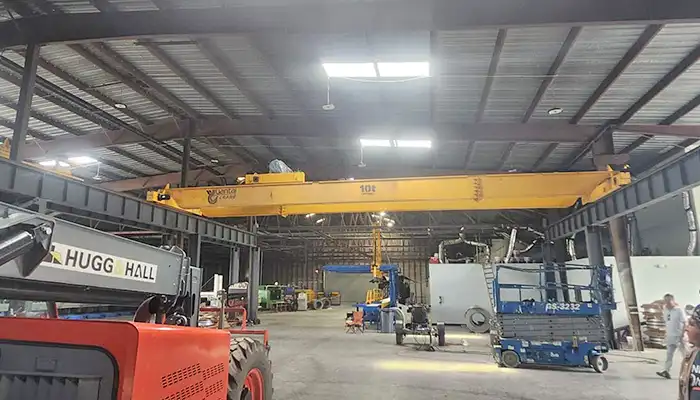
Affordable 10 ton double girder overhead crane with CD/MD hoist trolley, built for U.S. standards, ideal for construction and industrial lifting
Free consultation to Confirm Parameters & Specifications and Get
Latest Crane Price & Crane Rate.
- Types of overhead cranes : _______?
- Optional: Overhead travelling crane, goliath gantry crane,Slewing jib crane, Single girder or double girder crane,small portable crane or kbk crane, etc.
- Capacity of overhead crane: _______?
- Optional: 0.25ton, 0.5 ton, 1 ton, 2 ton, 3ton, 5 ton, 10 ton,15ton, 20ton, 25 ton, 30ton,35ton, up to 550ton, etc.
- Crane span & lifting height : _______?
- Crane travelling length : _____?
- Control of overhead crane:_______?
- Optional: pendant/ remote/cabin control
- Voltage supply of overhead crane:_____?
- Eg,: 380V50/60HZ,3Phase or others,etc.
- Application/usage of crane:_______?
- Eg,: Steel mill, ,injection mold, cement,stone, concrete,granite, general manufacturing, etc.
Just leave a message via the contact form and our hoist and crane engineer will contact you with in 24working hours.
Get In Touch
